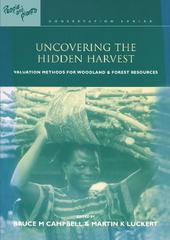
|
Uncovering the Hidden Harvest: Valuation Methods for Woodland and Forest Resources
Paperback
Main Details
| Title |
Uncovering the Hidden Harvest: Valuation Methods for Woodland and Forest Resources
|
| Authors and Contributors |
Edited by Bruce M. Campbell
|
|
Edited by Martin K. Luckert
|
| Series | People and Plants International Conservation |
|---|
| Physical Properties |
| Format:Paperback | | Pages:278 | | Dimensions(mm): Height 240,Width 170 |
|
| Category/Genre | Environmental economics
Management of land and natural resources |
|---|
| ISBN/Barcode |
9781853838095
|
| Classifications | Dewey:333.75 |
|---|
| Audience | | Undergraduate | | Postgraduate, Research & Scholarly | | Professional & Vocational | |
|---|
| Illustrations |
Photographs, figures, tables, boxes, bibliography
|
|
Publishing Details |
| Publisher |
Taylor & Francis Ltd
|
| Imprint |
Earthscan Ltd
|
| Publication Date |
1 December 2001 |
| Publication Country |
United Kingdom
|
Description
Forests and woodlands provide an enormous range of goods and services to society, from timber and firewood to medicinal plants, watershed protection, destinations for tourists and sacred sites. Only when these are understood and valued can forests and their resources be properly managed and conserved. This work shows how the complicated network of benefits can be untangled and sets out the different approaches needed to value them. It covers the analysis of plant-based markets, non-market valuation and decision frameworks such as cost-benefit analysis.
Author Biography
Bruce Cambell is an ecologist in the Research Division of the Center for International Forestry Research (CIFOR), Indonesia. Martin Luckert is Professor of Forest Economics at the Department of Rural Economy, University of Alberta, Canada, and a research associate with CIFOR.
Reviews"Uncovering the Hidden Harvest" is a practical handbook about helping local peoples in undeveloped countries understand the values of forests and forest conservation. This book is part of the invaluable "People and Plants Conservation Series," which is being supported by the World Wildlife Fund, UNESCO, and the Royal Botanic Gardens, Kew. Having recently traveled to parts of the world (Nepal and Ghana) where forest resources are used very primitively for cooking and heating, this reviewer found this book extremely useful in putting into words what he had surmised. The editors have pulled together a wonderful set of practical and usable chapters that cover economic values, rural markets, nonmarket values, and participatory and synthesis methods for integrating conservation into thinking about forest resource values. This book should be required reading for anyone promoting wise use of forest resources in developing countries, especially for Peace Corp volunteers. All levels." --- D. F.
|